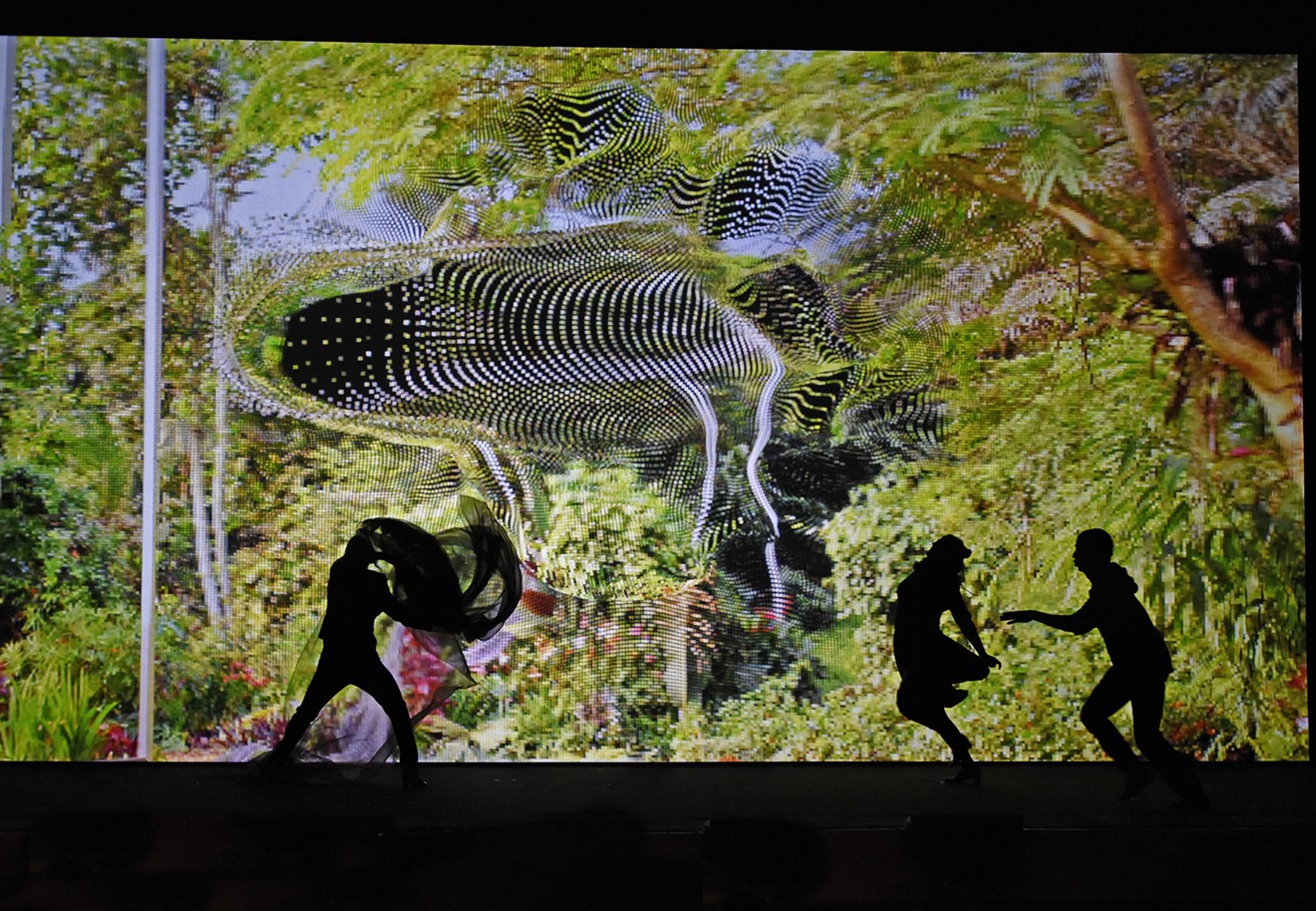The Dallas Opera presented the U.S. premier Friday night of Sunken Garden, a modern one-act opera first performed in 2013 at the English National Opera. The innovative composer Michel van der Aa collaborated with novelist David Mitchell, who wrote the libretto, to create a multimedia dramatic performance that is part opera and part film, with 3-D elements telling a story that is part science fiction and part mystery.
The complex storyline involves an independent documentary filmmaker named Toby Kramer, who has stumbled onto the disappearance of a man named Simon Vines. Kramer sets out to discover what happened to Vines as a film project. An arts foundation headed by a woman named Zenna Briggs offers to back Kramer financially. He shows her his preliminary work, which includes filmed interviews of Vines' landlady, Amber, who has also disappeared, and Vines' friend Sadaqat. Sadaqat resides in a mental hospital and asserts that one of the doctors there, Dr. Marinus, is involved in the disappearances of Amber and Vines.
The mystery revolves around the disappearances but morphs into the realm of science fiction after Kramer dreams about a peaceful garden that he sets out to find. When he stumbles upon a bright door, Kramer and the audience put on their 3-D glasses and enter the eponymous sunken garden where there are flowers, trees and holograms of Vines and Amber. We learn the backstories of the main characters and begin to see that guilt over a past error brought them all into this garden, also known as an "occult engine." We quickly discover that (surprise!) Briggs created it and brought them all here.
The storyline feels convoluted at times, but the world that van der Aa and Mitchell created works when disbelief and preconceptions of what makes an opera are suspended. As we left the opera, a woman in the elevator said she felt like she spent two hours in a mental hospital.
The recorded and mostly spoken interviews that are used to reveal a large part of the story can at times make it seem more like a film and less like a live performance. However, there are three singing performances by actors onstage accompanied by an orchestra.
Roderick Williams is fresh-faced and convincing as Kramer, who becomes increasingly obsessed with solving the mystery of the disappearances. His falsetto rang with tenderness as he fell for Amber, and their duet was surprisingly moving, considering Amber only appears in the form of iPhone videos.
Appearing via recorded video projection, Kate Miller-Heidke sang and acted the role of Amber and had one of the most striking musical elements in the performance. She revealed her torment by repeating the words "backstreets of waking and sleeping" as her image was magnified in panels above the stage.
Baritone Jonathan McGovern gave an impassioned performance as the guilt-ridden Vines. His heartfelt videotaped statement brings closure to the story.
Onstage, sopranos Katherine Manley as Briggs and Micah Persson as Dr. Marinus were flawless. Both displayed fierceness in their roles and confidently overcame a bit of awkwardness when the two engage in a tussle. Caroline Jay as Amber’s mother provides comic relief as well as a bit of commentary on contemporary art.
Nicole Paiement demonstrated her prowess as a conductor of modern opera by seamlessly knitting together the orchestra’s live performance with recorded musical segments. Sound designer Tom Gelissen managed the challenges presented by the live and recorded elements of this complex production. Set and lighting designer Theun Mosk incorporated simple industrial poles and transparent fabric as panels for the visual projections.
Librettist David Mitchell is especially adept at implicitly communicating his philosophy with beautiful and mysterious lyrics. Mitchell’s image of dusk as the place between light and dark, life and death was especially powerful.
In Sunken Garden, van der Aa moved outside the boundaries of opera to create a fantasy world where the difficult questions of life cannot be escaped. This dense story is filled with symbolism and allegory. The most prominent examples concern guilt, sorrow, and the choice between an authentic life and a virtual one.
[
{
"name": "Air - MediumRectangle - Inline Content - Mobile Display Size",
"component": "18855504",
"insertPoint": "2",
"requiredCountToDisplay": "2"
},{
"name": "Editor Picks",
"component": "17105533",
"insertPoint": "4",
"requiredCountToDisplay": "1"
},{
"name": "Inline Links",
"component": "18349797",
"insertPoint": "8th",
"startingPoint": 8,
"requiredCountToDisplay": "7",
"maxInsertions": 25
},{
"name": "Air - MediumRectangle - Combo - Inline Content",
"component": "17105532",
"insertPoint": "8th",
"startingPoint": 8,
"requiredCountToDisplay": "7",
"maxInsertions": 25
},{
"name": "Inline Links",
"component": "18349797",
"insertPoint": "8th",
"startingPoint": 12,
"requiredCountToDisplay": "11",
"maxInsertions": 25
},{
"name": "Air - Leaderboard Tower - Combo - Inline Content",
"component": "17105535",
"insertPoint": "8th",
"startingPoint": 12,
"requiredCountToDisplay": "11",
"maxInsertions": 25
}
]











